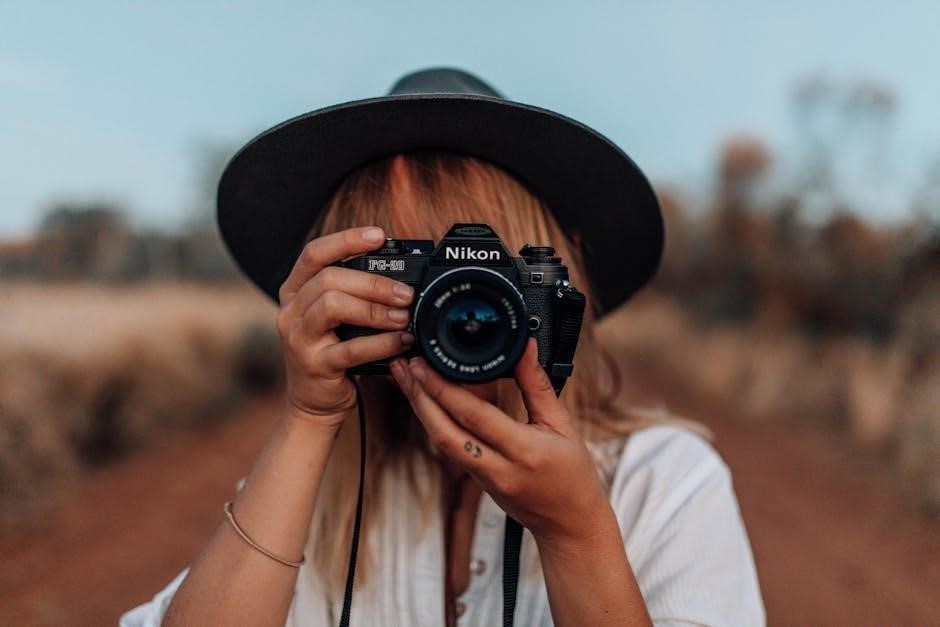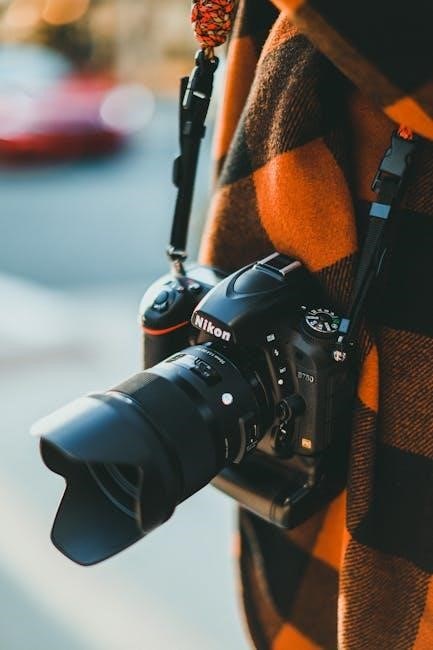The Nikon D3300 is an entry-level DSLR camera designed for beginners, offering excellent image quality and user-friendly features․ Its owner’s manual is essential for understanding its operations․
1․1 Overview of the Nikon D3300 DSLR Camera
The Nikon D3300 is a high-performance, entry-level DSLR camera designed for photography enthusiasts․ It features a 24․2-megapixel CMOS sensor, delivering sharp images with vibrant colors․ The camera supports Full HD video recording at 1080p and offers a wide ISO range of 100-12,800 for excellent low-light performance․ Weighing just 410 grams, it is lightweight and ergonomic, making it easy to handle for extended periods․ The D3300 includes an 11-point autofocus system and a variety of shooting modes, catering to both beginners and advanced users․ Its Guide Mode simplifies complex settings, helping new photographers master their skills․ This camera is an ideal choice for those seeking quality and affordability in a DSLR․
1․2 Importance of the Owner’s Manual
The Nikon D3300 owner’s manual is indispensable for maximizing the camera’s potential․ It provides detailed explanations of features, modes, and settings, ensuring users understand how to operate the camera effectively․ The manual aids in troubleshooting common issues, such as error messages or focus problems, and offers guidance for customization․ It is particularly valuable for beginners, as it explains complex functions in an accessible manner․ The manual also covers default settings and menu navigation, helping users tailor the camera to their needs․ Accessible in PDF format via Nikon’s official website or the Manual Viewer 2 app, the manual is a comprehensive resource for mastering the D3300, whether you’re a novice or an experienced photographer․

Where to Download the Nikon D3300 Manual
The Nikon D3300 manual is available for free download on Nikon’s official website and via the Nikon Manual Viewer 2 app, ensuring easy access to the PDF guide․
2․1 Official Nikon Website
The official Nikon website provides direct access to the Nikon D3300 manual․ Visit http://nikonimglib․com/manual/, select your language, and download the PDF reference or user manual․ This ensures you receive the most accurate and up-to-date guide․ The manual is free and available without registration, offering detailed instructions for camera settings, shooting modes, and troubleshooting․ It is structured to help users master the D3300’s features, from basic operations to advanced techniques․ The official source guarantees reliability, making it the best starting point for understanding your camera’s full potential․
2․2 Third-Party Resources and PDF Downloads
Beyond the official Nikon website, third-party platforms like Scribd and forums offer downloadable PDF versions of the Nikon D3300 manual․ These resources are convenient for quick access but may lack official verification․ Users can search for “Nikon D3300 manual PDF” on such sites to find downloadable files․ However, caution is advised to ensure the manual’s authenticity and safety․ Some third-party hosts may include additional guides or translations, which can be helpful for international users․ Always verify the source to avoid downloading outdated or incorrect versions․ These resources are useful alternatives when the official site is inaccessible or for those preferring offline access without official registration․

Key Features of the Nikon D3300
The Nikon D3300 features a 24․2MP APS-C sensor, Full HD video recording, and an 11-point autofocus system․ Its lightweight design and user-friendly interface make it ideal for beginners․
3․1 Camera Specifications
The Nikon D3300 boasts a 24․2-megapixel APS-C CMOS sensor, delivering high-resolution images with excellent detail․ It utilizes the EXPEED 4 image-processing engine for enhanced performance․ The camera features a 3-inch LCD screen with 921k-dot resolution for clear image preview and playback․ It supports Full HD video recording at 1080p with frame rates up to 60fps․ The ISO range extends from 100 to 12,800 (expandable to 25,600), ensuring versatility in various lighting conditions․ The D3300 also includes an 11-point autofocus system for quick and precise subject tracking․ Built-in pop-up flash and compatibility with Nikon’s F-mount lenses provide additional creative flexibility․
3․2 Sensor and Image Quality
The Nikon D3300 features a 24․2-megapixel APS-C CMOS sensor, delivering sharp and detailed images with vibrant colors․ Paired with the EXPEED 4 image processor, it ensures efficient noise reduction and improved overall image quality․ The sensor captures a wide dynamic range, preserving both highlights and shadows, even in challenging lighting conditions․ Low-light performance is impressive, with an ISO range of 100-12,800 (expandable to 25,600)․ The camera produces crisp JPEGs straight out of the box and offers RAW file support for advanced post-processing․ Its ability to render fine details and accurate colors makes it ideal for enthusiasts and professionals alike, providing a solid foundation for creative photography․
3․3 Video Recording Capabilities
The Nikon D3300 supports Full HD video recording at 1080p with frame rates up to 60fps, enabling smooth motion capture․ It also features continuous autofocus during recording, ensuring sharp focus on moving subjects․ The camera includes a built-in microphone for audio capture, and users can connect an external microphone for enhanced sound quality․ The manual provides detailed guidance on adjusting video settings, such as exposure compensation and ISO sensitivity, to optimize video output․ With its user-friendly interface and robust video features, the D3300 is an excellent choice for capturing high-quality video content, making it ideal for both casual and creative videography projects․

Shooting Modes
The Nikon D3300 offers various shooting modes, including Auto, Manual, Aperture Priority, Shutter Priority, and Scene Modes, catering to different photography needs and skill levels effortlessly․
4․1 Auto Mode
The Auto Mode on the Nikon D3300 simplifies photography by automatically adjusting settings like aperture, shutter speed, and ISO for optimal results․ This mode is ideal for beginners, ensuring sharp and well-exposed images without manual adjustments․ The camera analyzes the scene and selects the best settings, making it perfect for casual shooting․ Users can rely on Auto Mode for quick, hassle-free photography, allowing them to focus on composition and creativity while the camera handles technical details․ This feature is especially useful in varying lighting conditions, providing consistent results with minimal effort required from the photographer․
4․2 Manual Mode (M)
Manual Mode (M) on the Nikon D3300 offers full control over camera settings, allowing photographers to adjust aperture, shutter speed, and ISO independently․ This mode is ideal for experienced users or those seeking creative control․ By manually setting these parameters, photographers can achieve specific effects, such as motion blur or depth of field․ The camera’s LCD screen provides real-time feedback, enabling precise adjustments․ Manual Mode is particularly useful in complex lighting conditions where automatic settings may not produce the desired result․ It requires a good understanding of photography fundamentals but offers unparalleled flexibility for capturing images exactly as envisioned․ This mode is a powerful tool for mastering advanced techniques and unlocking the camera’s full potential․
4․3 Aperture Priority (A/Av) and Shutter Priority (S/Tv)
Aperture Priority (A/Av) and Shutter Priority (S/Tv) modes on the Nikon D3300 provide semi-automatic control, balancing user input with camera automation․ In Aperture Priority, users set the aperture (f-stop), and the camera adjusts shutter speed to maintain proper exposure․ This mode is ideal for controlling depth of field, such as isolating subjects or ensuring landscape sharpness․ Shutter Priority allows setting the shutter speed, with the camera adjusting aperture, perfect for capturing motion—freezing action or creating blur․ Both modes offer flexibility, letting photographers focus on creative aspects while the camera handles exposure calculations․ They are versatile options for those transitioning from auto to manual shooting, enhancing control without full manual complexity․
4․4 Scene Modes
The Nikon D3300 offers a variety of Scene Modes tailored for specific shooting situations, ensuring optimal results without manual adjustments․ Portrait mode emphasizes subject sharpness and softens backgrounds, while Landscape mode enhances detail and color in wide-angle shots․ Night Portrait mode captures low-light scenes with balanced flash and background brightness․ Sports mode freezes fast-moving subjects, and Close-up mode optimizes detail for macro photography․ These modes simplify photography by automatically adjusting settings like aperture, shutter speed, and ISO, making it easier for beginners to achieve professional-looking images․ Scene Modes are accessible via the Mode Dial, providing quick access to tailored settings for common photography scenarios, enhancing creativity and convenience for users of all skill levels․

Camera Settings and Customization
The Nikon D3300 offers a user-friendly menu system for customizing settings, including white balance, ISO, and autofocus modes, allowing photographers to tailor the camera to their preferences and enhance image quality․
5․1 Understanding the Menu System
The Nikon D3300’s menu system is intuitive, providing easy access to settings and features․ It is divided into categories such as Playback, Shooting, Setup, and Retouch menus․
- Playback Menu: Allows reviewing and editing images, managing playback settings, and creating slideshows․
- Shooting Menu: Customize settings like white balance, ISO sensitivity, and autofocus modes for optimal image capture․
- Setup Menu: Adjust camera preferences, such as monitor brightness, language, and firmware updates․
- Retouch Menu: Apply in-camera editing options like cropping, resizing, and filter effects to your photos․

Users can navigate the menu using the multi-selector and OK button, making it easy to tailor settings to their shooting style․ Customization options like My Menu allow quick access to frequently used settings․
5․2 White Balance and ISO Settings
White balance and ISO settings are crucial for capturing accurate colors and managing light sensitivity․ The Nikon D3300 offers multiple white balance options, including Auto, Daylight, Shade, Cloudy, and Fluorescent settings, as well as the ability to fine-tune or set custom white balance․ The ISO range spans from 100 to 12,800, allowing photographers to shoot in various lighting conditions․ Lower ISO settings (e․g․, ISO 100) are ideal for bright environments, while higher ISOs (e․g․, ISO 6400) are better suited for low-light situations․ However, high ISOs may introduce noise․ The camera also features noise reduction settings to help minimize grain in images shot at higher sensitivities․
5․3 Autofocus Modes
The Nikon D3300 offers three primary autofocus modes: Single AF (AF-S), Continuous AF (AF-C), and Auto AF (AF-A)․ Single AF focuses when the shutter button is pressed halfway and locks the focus․ Continuous AF adjusts focus continuously while the button is pressed, ideal for moving subjects․ Auto AF automatically selects between Single and Continuous AF based on the scene․ You can switch modes using the AF-mode button on the lens or through the camera menu․ Understanding these modes helps optimize focus accuracy in various shooting scenarios, ensuring sharper images whether your subject is stationary or in motion․

Accessories for the Nikon D3300
Essential accessories include high-quality lenses, tripods for stability, memory cards for storage, and optional external flashes to enhance functionality and versatility of the camera․
6․1 Lenses
The Nikon D3300 is compatible with a wide range of Nikon F-mount lenses, offering flexibility for various photography needs․ The kit includes an 18-55mm lens, ideal for everyday shooting․ Optional lenses like the 50mm f/1․8 prime or 70-300mm zoom provide enhanced creativity and image quality; Lenses with VR (Vibration Reduction) reduce blur in low-light conditions․ When selecting lenses, ensure compatibility with the F-mount and AF contacts for autofocus functionality․ Proper lens maintenance and cleaning are crucial for optimal performance․ Refer to the manual for guidance on lens attachment and usage to maximize your camera’s potential and explore different photographic styles effectively․
6․2 Tripods and Stabilization
A tripod is essential for stabilizing the Nikon D3300, especially in low-light conditions or when using slower shutter speeds․ It ensures sharp images and prevents camera shake․ The camera supports various tripod models with standard mounts․ For added stability, lenses with Vibration Reduction (VR) technology reduce blur caused by hand movement․ Using a tripod in conjunction with VR lenses enhances image clarity․ The manual provides guidelines for tripod setup and usage, helping photographers achieve professional-quality results․ Proper stabilization is crucial for capturing crisp photos, particularly in time-lapse or long-exposure photography․ Always refer to the manual for optimal tripod and VR configuration to maximize your camera’s performance and image quality․
6․3 Memory Cards and Storage
The Nikon D3300 supports SD, SDHC, and SDXC memory cards, with compatibility for UHS-I for faster data transfer․ Using high-speed cards is recommended, especially for video recording․ The camera allows for in-camera formatting of memory cards, ensuring proper setup for capturing images and videos․ Always format cards in the camera to avoid data loss․ For optimal performance, use cards with a minimum of Class 6 or higher․ The D3300 can store thousands of images, depending on card capacity․ Using multiple memory cards can help organize photos and videos․ Ensure cards are genuine and compatible to avoid errors․ Proper storage and handling of memory cards are crucial for maintaining data integrity and camera performance․

Maintenance and Care
Regular cleaning of the camera and lens prevents dust buildup․ Store the camera in a cool, dry place to maintain performance and longevity․ Follow manual guidelines carefully․
7․1 Cleaning the Camera and Lens
Regular cleaning is crucial for maintaining the Nikon D3300’s performance․ Use a soft, dry microfiber cloth to wipe the camera body and lens, avoiding harsh chemicals․ For stubborn smudges, lightly dampen the cloth with distilled water, but ensure no moisture enters the lens or camera․ A blower brush is ideal for removing dust from the lens and sensor․ Avoid touching the lens surface, as oils from skin can leave smudges․ For deep cleaning, use a lens cleaning solution and a microfiber cloth specifically designed for optics․ Never use tissues or paper products, as they may scratch the lens․ Cleaning should be done in a dry, dust-free environment to prevent contamination․ Always refer to the manual for detailed cleaning instructions to ensure proper maintenance and longevity of your equipment․
7․2 Battery and Charger Maintenance
Proper care of the Nikon D3300’s battery and charger ensures optimal performance and longevity․ Avoid extreme temperatures, as they can drain the battery or reduce its capacity․ Store the battery in a cool, dry place when not in use․ Use the provided charger to prevent damage from incompatible adapters․ Charge the battery until it reaches full capacity, as overcharging can degrade its performance․ Clean the battery terminals with a soft cloth to maintain good connectivity․ Replace the battery if it no longer holds a charge or shows signs of swelling․ Always follow the manual’s guidelines for charging and storage to preserve the battery’s health and ensure reliable operation of your camera․

Common Issues and Troubleshooting
The Nikon D3300 may encounter issues like error messages or focus problems․ Refer to the manual for troubleshooting steps or contact Nikon support for assistance․
8․1 Error Messages
The Nikon D3300 may display error messages related to lens detection, memory card issues, or file formatting․ These errors are often resolved by resetting the camera, cleaning the lens contacts, or formatting the memory card as instructed in the manual․ For instance, an “Err” message typically indicates a communication issue between the camera and lens, which can be fixed by disconnecting and reconnecting the lens․ The manual provides detailed explanations and solutions for common error codes, ensuring users can troubleshoot effectively․ Regularly updating firmware and maintaining proper camera care can prevent many of these issues from occurring․ Always refer to the manual for specific guidance on resolving error messages․
8․2 Focus and Exposure Problems
Focus issues, such as difficulty autofocusing or blurry images, can occur due to incorrect AF-mode selection or dirty lens contacts․ Ensure the lens is clean and properly attached․ Exposure problems, like overexposed or underexposed photos, may result from incorrect aperture, shutter speed, or ISO settings․ Use the built-in light meter to adjust settings for balanced exposure․ Refer to the manual for guidance on using exposure compensation․ If focus issues persist, reset the camera to default settings or update the firmware․ For consistent results, experiment with different shooting modes and settings․ Regularly cleaning the lens and sensor can also improve focus and image quality․ Always consult the manual for troubleshooting specific focus and exposure scenarios․

Additional Resources
Explore the Nikon Manual Viewer 2 app for easy access to the D3300 manual on your smartphone or tablet․ Join online forums and communities for tips and support․
9․1 Nikon Manual Viewer 2 App
The Nikon Manual Viewer 2 app allows users to access the D3300 manual anytime, anywhere․ Available for iOS and Android devices, it provides an intuitive interface to navigate through the manual’s content․ Key features include keyword search, bookmarking, and offline access, making it a convenient tool for photographers on the go․ The app ensures that users can quickly reference camera settings, shooting modes, and troubleshooting tips without the need for a physical copy․ Regular updates ensure compatibility with the latest devices and camera models, making it an essential resource for D3300 owners seeking to master their camera’s functionality․
9․2 Online Communities and Forums
Online communities and forums dedicated to the Nikon D3300 provide valuable resources for users․ Platforms like Nikon Club Ufficiale and photography forums offer extensive discussions, troubleshooting tips, and shared experiences․ These communities allow users to interact with experienced photographers, resolve common issues, and learn advanced techniques․ Many forums also host detailed guides and downloadable resources, including manuals and tutorials․ By engaging with these communities, D3300 owners can gain insights, enhance their photography skills, and stay updated on the latest developments․ These online spaces foster collaboration and learning, making them indispensable for mastering the Nikon D3300 and improving overall photography knowledge․
The Nikon D3300 is a versatile DSLR camera with robust features․ By mastering its manual and exploring resources, users can unlock its full potential for stunning photography․
10․1 Final Tips for Mastering the Nikon D3300
To fully master the Nikon D3300, start by thoroughly reading its manual to understand all features and settings․ Practice using different shooting modes, such as Manual (M) and Aperture Priority (A), to gain control over your photography․ Regularly clean and maintain your camera and lenses to ensure optimal performance․ Experiment with various accessories like tripods and additional lenses to expand your creative possibilities․ Utilize the Nikon Manual Viewer 2 app for quick reference and join online communities for tips and inspiration․ Finally, keep your firmware updated and explore tutorials to stay informed about the latest techniques and best practices․
